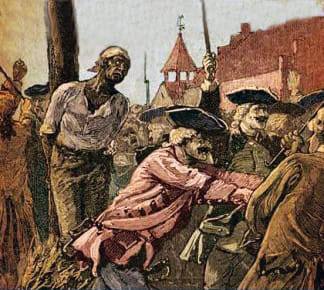North American colonial society carried over the cultural baggage of a worldview equating blackness with evil, and projected it upon enslaved Africans. New Jersey records show that Blacks were not considered christians: a bounty on wolves offered “ten shillings to Negroes and Indians and twice that sum to ‘Christian killers’.” [Matthiessen, Wildlife in America, Viking, 1988]
Anglo-American slaveholders imposed an intense cultural suppression on Africans, far greater than in Caribbean and South American slave states. In the English colonies, whites greatly outnumbered Blacks, who were often separated from each other. Also, Catholicism was relatively tolerant of syncretism of African deities with its saints. Protestant colonials brooked no sacred images, no dancing, and they outlawed the drums.
What many people don’t know is that burning at the stake, a European punishment for witches, heretics, and Jews, persisted amidst the institutional violence used to perpetuate chattel slavery. In 1741, thirteen African-Americans men were burned at the stake in New York City, and another seventeen hanged, on charges of planning a revolt against slavery.



